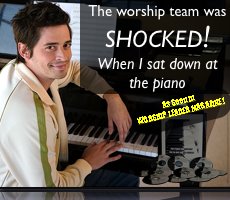Worship music is dynamic music performed for a live audience, so you can respond to the needs of the congregation as you lead. If they are loving a song and singing enthusiastically, you can keep going. If their eyes are glazing over and they are glancing at their watches, you can end it before you lose your congregation to Sunday football. This flexibility can be a great strength, if you learn how to navigate the changes.
The order of the sections of the song are called the "song form." While there are no rules about how song form needs to be, there are definitely common forms that help us take a good guess at what's coming.
Let's look at the two basic parts of most worship songs:
The Chorus:
Let's look at the two basic parts of most worship songs:
The Chorus:
Modern music revolves around the chorus. The chorus is generally the most intense, high-energy part of the song, and contains the main point of the song. It is the part everyone remembers, the part you can hum even if you don't know the song very well. The song exists to build toward the chorus.
The Verse:
The verse elaborates on the main point of the chorus. It is usually lower in energy and feels like it is building toward the chorus. Most songs begin with the verse, but end with the chorus.
Here's our shorthand system:
VERSE = V
VERSE 1 = V1; VERSE 2 = V2
CHORUS = C
Verse + Chorus = V - C We will call one time through the verse and chorus "once down."
NOW OUR GAME!
“GUESS WHERE THE SONG IS HEADED!”
We'll pretend we're playing a song with the band, and guess where it’s likely to go next.
V1 - C - ???
The most likely answer is verse two. We've already gone "once down" the song--after we've completed the first chorus the song has an identity crisis, because it has reached its goal. (Remember, the song exists to go to the chorus.) So we'll usually to go back to the verse to "reset."
V1 - C - V2 - ???
The answer, of course, is the chorus. Verse two would feel like it was building toward it. This completes our cycle, "twice down" the song.
V 1 - C - V2 - C - ???
Now here's the part of the song that will trip you up more than any other. At this point the song has built to the chorus twice and become predictable. It is most likely that it will repeat the chorus one more time, because it’s unexpected, and gives a sense of acceleration and excitement that leads to the conclusion of the song.
So there you have it. Our most common simple song form. We could call it "twice down, extra chorus." V1 - C - V2 - C - C
Here are some common variations.
Notice that there is only one change to our basic form.
1. Add a third time down: V1 - C - V2 - C - V3 - C - C. This makes a longer song.
2. Double the first verse: V1 - V2 - C - V3 - C - C. This stretches out the anticipation, gives a longer climb to the chorus.
3. Start with the chorus: C - V1 - C - V2 - C - C. This kicks the song off with a lot of energy right away.
Next in the series we will look at other sections like the intro, outro, prechorus, tag, turnaround, vamp, and bridge. We’ll make even the most complex song forms easy to follow, looking at examples from songs you know. You’ll never be lost in the song again!
Notice that there is only one change to our basic form.
1. Add a third time down: V1 - C - V2 - C - V3 - C - C. This makes a longer song.
2. Double the first verse: V1 - V2 - C - V3 - C - C. This stretches out the anticipation, gives a longer climb to the chorus.
3. Start with the chorus: C - V1 - C - V2 - C - C. This kicks the song off with a lot of energy right away.
Next in the series we will look at other sections like the intro, outro, prechorus, tag, turnaround, vamp, and bridge. We’ll make even the most complex song forms easy to follow, looking at examples from songs you know. You’ll never be lost in the song again!


No comments:
Post a Comment